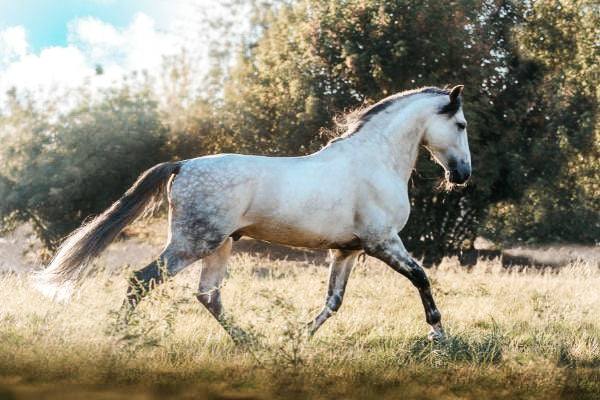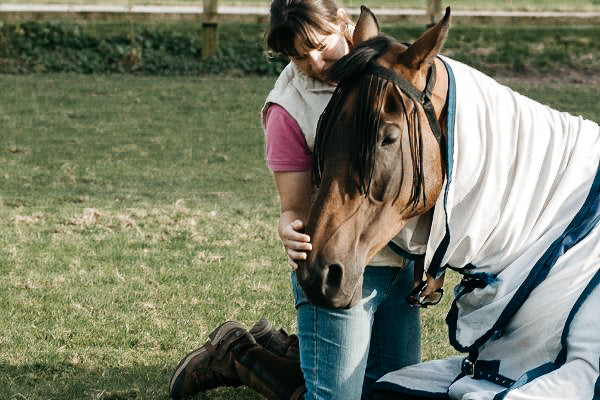
Horse feeding
Every horse owner only wants the best for their beloved horse. Of course, this also applies when it comes to horse feeding. Horse feeding in particular is a complex topic that the horse owner should deal with intensively, because by choosing the right feed you can have a positive influence on the horse's health and well-being. Horse owners naturally ask themselves a variety of questions:
What belongs in the feeding trough and what should you avoid? Does feeding hay from hay nets/hay racks make sense? Can additional feed support muscle building in horses?

We will get to the bottom of all these questions and other important information about horse feeding. First of all, we should get a rough overview of the different types of horse feed.
What types of food are there?
Roughage: Roughage forms the basis of every good horse feed. Hay, straw and haylage are referred to as roughage. It is extremely important that the feed is of high quality so that the horse gets enough nutrients. As a rule of thumb: 2 kg of roughage should be fed per 100 kg of horse.
Concentrated feed: Individual feed such as oats, barley, corn, wheat bran and muesli belong to the group of concentrated feed. As the name suggests, these types of feed provide the horse with additional energy.
Compound feed: Compound feed includes e.g. b Supplementary feed, vitamin and mineral feed for horses. These feed additives can provide your horse with special vitamins and trace elements. You feed these preparations, for example, to strengthen your horse's immune system (rose hip) or to build muscle in the horse (protein).
Juice food: Feed carrots, beets, beetroot, apples and grass are part of the juice food. The juice food provides energy, but above all important vitamins. Therefore, fodder carrots etc. especially liked to be fed in winter.
Additions in feeding: Anything your horse gets out of turn is referred to as additional feed. Be it a tasty warm portion of mash in winter, a bowl of beet pulp for the horse to feed or a portion of oil when she changes her coat.

Herbs for horses
Many horse owners swear by it – herbs for horses. But before you throw all the herbs into the feeding trough, you should find out about the properties and effects of the respective herbs for horses.
Which herbs have a positive effect in horse feeding?
- Marigolds – to support skin and mucous membranes
- Rosehips – high vitamin C content and other valuable ingredients
- Stinging nettle – stimulates metabolism
- Icelandic moss – maintain and. protect the mucous membranes
- Ribwort plantain – supports the bronchi
- Cattlewort – Support metabolism and joints
- Dandelion – Detoxification of the liver and gallbladder
- Propolis – for a strong immune system
- Horehound herb – f. healthy appetite etc. good digestion
- Fenugreek – digestive and. slightly laxative
- Psyllium husks – to support the self-cleaning of the intestines
- Chamomile – anti-inflammatory, to soothe the gastrointestinal tract
- Biotin – stable hooves
- Diatomaceous earth – healthy skin and... good hoof growth
- St. John's wort - for good nerves etc. for relaxation
- Melissa – relaxing, against cramps and flatulence
- Devil's claw - healthy joints, swelling in edema, mild pain
- Milk thistle – regeneration and detoxification of the liver
- Hawthorn – to strengthen the heart and circulation etc. Vascular dilatation
- Caraway – relaxing, against cramps and flatulence
Of course, this is only a small selection of the most common herbs for horses. You can of course use the Internet for further herbs and information, but an animal health practitioner and your veterinarian can certainly help you.
Is it useful to feed hay from a hay net or a hay rack?
The wild horses used to spend up to 18 hours a day searching for food. They covered several kilometers a day and always filled their stomachs with small portions along the way. There were no long breaks from eating and the digestive tract always stayed going. This behavior is of course completely different from that of our current domestic horse. It therefore makes sense to get the hay from a hay net or to feed from a rack. The horses spend longer eating and eat small portions. This can e.g. b reduce the risk of colic.
ATTENTION: Please do not attach the hay net too low otherwise there is a high risk of injury.
Can additional feed support muscle building in horses?
Especially after a long winter break, during which our horses have usually not been trained as usual, it is important to rebuild the horse's muscles and condition. However, the best training plan is of no use if the feeding is not correct and our horse is not adequately cared for. It's similar the other way around, the best supplementary feed for building muscle is no good if the horse just stands in the paddock most of the time. To build muscle, it is essential to alternate between training sessions and rest phases with appropriate additional food.
A well-known supplementary food for building muscle is rice germ oil. Rice germ oil contains gamma-oryzanol, which is known for its muscle-building effect.
Caution with tournament horses: Rice germ oil must be discontinued 48 hours before the start of the tournament.
Mineral feed for horses
Mineral feed for horses comes in different forms.
Mineral bar: The pre-portioned form allows for quick and easy feeding without the hassle of weighing or measuring. The mineral bar can be fed by hand as easily as a treat. This makes the bars ideal for horses that live on pasture or in open stables.
Mineral pellets: Pellets are the most common form of mineral feed for horses. These can simply be mixed into the horse's concentrated feed for feeding. A measuring cup and feeding recommendations are usually included with the product.
Mineral powder: Like the mineral pellets, the mineral powder can simply be mixed into the concentrated feed. Here too, you have to weigh or measure. However, many horses like to sort out in the trough. Especially with powder, it is difficult to ensure that the horse consumes all of the powder. It is therefore advisable to use bars if you have picky horses.
Alfalfa – what is it actually?
Alfalfa has been used in horse feed for many years. But what is behind this plant?
Today, alfalfa is experiencing a real HYPE in feeding horses. Almost every horse owner feeds alfalfa to their horse. Alfalfa is an overwintering, perennial plant from the snail clover genus with a height of up to one meter. The flowering period is between June and September.
Benefits of alfalfa:
- low sugar and starch = low energy content
- suitable for horses with sensitive stomachs as the structure causes the horse to salivate more intensively on the alfalfa
- lots of calcium and little phosphorus
- provides important protein e.g. b with poor hay quality
Disadvantages of alfalfa:
- possible damage to the gastric mucosa (alfalfa chaff)
- inhibits nutrient absorption in horses
- Grazing or grass feeding can lead to an excess of protein

Basic rules for feeding horses
Finally, here are some simple basic rules that have a positive effect on horse feeding and can generally be applied to every horse.
1. Roughage always before concentrated feed
As already mentioned, roughage is the basis of horse feeding. For horses that are only ridden or exercised moderately or not at all, the roughage is usually sufficient.
2. Feed hay from hay nets/hay racks
The slower food intake means your horse doesn't have to take long breaks to eat.
3. Drink
Make sure your horse drinks enough fluids. Your horse should always have free access to clean and fresh drinking water!
4. Feeding troughs
Make sure that the troughs are always clean and that no bacteria can settle there and spread.
5. Feed small portions
Distribute the daily amount of food for your horse into several portions. The horse's stomach is comparatively small and should not be overwhelmed with large portions.
6. Energy requirement
If your horse needs more energy e.g. b When changing coats, please do not increase the amount of concentrated feed, but rather add a dash of oil to the feed. Oil is a high-quality energy supplier and is easier to digest than concentrated feed. Linseed oil, sunflower oil or rapeseed oil are suitable here.
7. Time and peace to eat
Give your horse enough time and rest to eat so that he doesn't have to swallow. It is recommended to feed the portion of hay first and the concentrated feed some time later. This means the horses already have something in their stomachs and no longer eat the concentrated feed so greedily.
8. Store food
Feeding bins are ideal for storing food. This keeps the food dry and cool.
The topic of horse feeding is a super complex topic. Horse feeding should therefore be individually adapted to each horse. Various factors such as health, age, husbandry and stress on the horse always play a decisive role. If you are unsure about feeding, feeding experts can help you with advice and support.
Discover more posts

Of course, every layman knows what one imagines a horse to be. But what exactly is a gaited horse? Doesn't every horse have gaits? Of course every horse has gaits, but a gaited horse has more gaits...
Continue reading
Introduction The training of a horse is important - owner or Trainers observe the animal very closely. But horses often suffer from stress (e.g.b. through requirements, training sessions...
Continue reading
